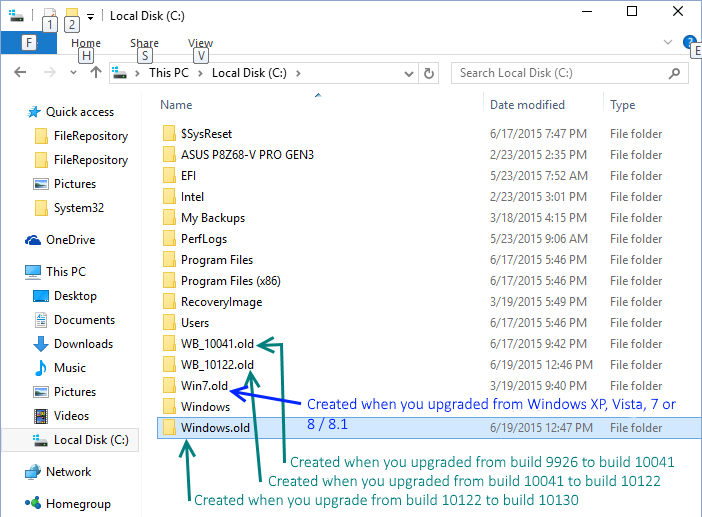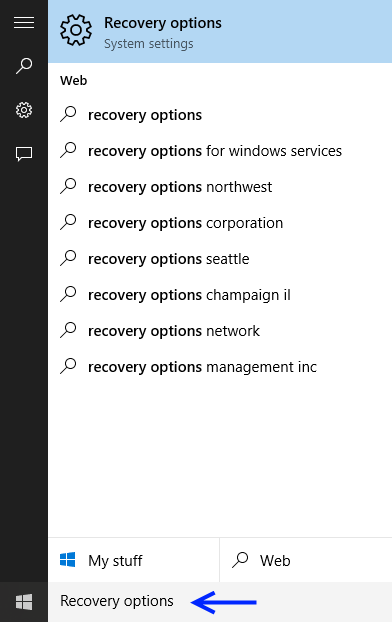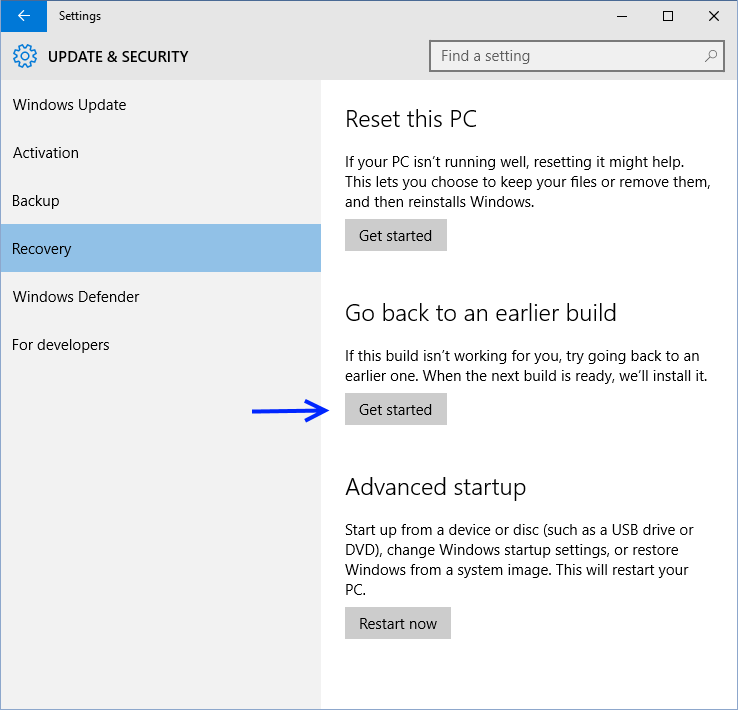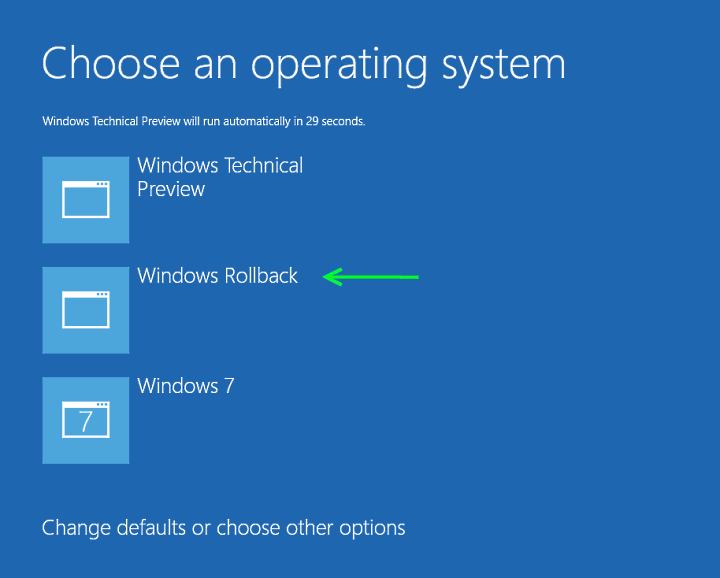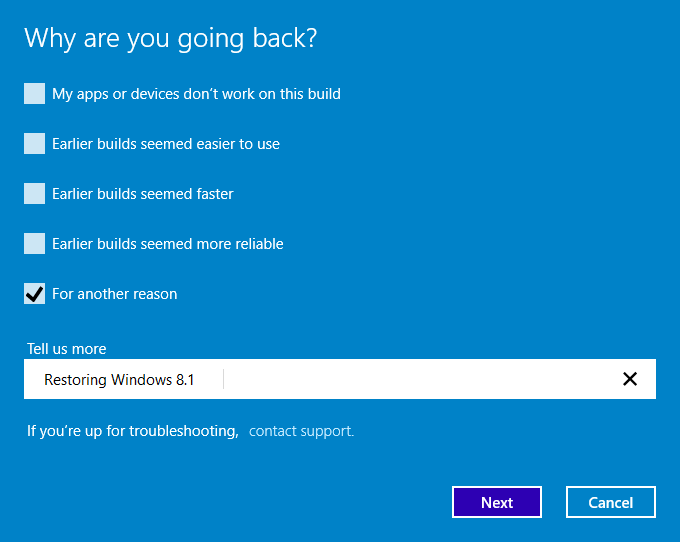Summary
Builds 9926, 10041, 10049, 10061, 10074, 10122, 10130 and later builds (17713) including the Spring 2018 Edition of Windows 10 support a Recover / Rollback feature that allows you to go back to the version of Windows installed on your PC prior to installing the latest build or version of Windows 10. This is a onetime only rollback to the previous build or version, but I've added a set of instruction on how to "Trick" Windows 10 into rolling back to your original installation of Windows XP, Vista, & or 8 / 8.1
Users who have a dual boot configuration or started with a clean install of an earlier build of the Windows 10 Preview: The rollback feature will restore the previous build you installed.
Note: If you have not installed a later build after your initial upgrade to Windows 10 from Windows 7 or Windows 8.1, I'll show you a trick on how to roll back to Windows 7 or Windows 8 / 8.1
The Trick:
Warning: For this trick to work you must rename the C:\Windows.old file (before 10 days elapses) to for example: Win8.old or Win7.old You must rename the Windows.old immediately before you install the next build for this to work.
Details
If you were running an earlier version of Windows (XP, Vista, Windows 7 or 8.0 / 8.1) before installing a Windows Insider Build then you can use this option to uninstall Windows 10 and restore your previous version of Windows without losing your earlier version’s applications, documents, photos and other personal files.
Note: Applications installed and personal settings changes made in Windows 10 will not be saved, however newly created Windows 10 documents, photos and other personal files will be migrated back to your earlier version of Windows.
If you were running an earlier version of Windows (XP, Vista, Windows 7 or 8.0 / 8.1) you can use this option to either; uninstall Windows 10 or rollback to the previous build of Windows 10 and restore your previous version of Windows without losing your earlier version’s applications, documents, photos and other personal files.
Note: Applications installed and personal settings changes made in Windows 10 will not be saved, however newly created Windows 10 documents, photos and other personal files will be migrated back to your earlier version of Windows.
Let’s get started:
Notes:
1)If you have renamed the Windows.old folder prior to upgrading from one build to the next released build and want to recover and want to recover Windows XP, Vista, 7 or 8.0 / 8.1 perform the steps A B and C below before proceeding to Recover / Rollback using either method 1, 2 or 3. After the recovery has completed proceed to the Cleanup section at the end of this Wiki article.
2)If you just want to roll back from the current build to the previous build then skip over steps A, B and C and proceed to methods 1, 2, or 3. Remember that once you rollback to an earlier build you will not be able to recover your original installation of Windows (XP, Vista, Windows 7 or 8.0 / 8.1).
Note:The rollback feature works only one time, subsequent attempts will fail.
How to recover XP, Vista, Windows 7 or 8.0 / 8.1
A)Assuming you have upgraded from XP, Vista, Windows 7 or 8.0 / 8.1 to build 10041 or a later build and then renamed the Windows.old folder to Win81.old for example, Windows 10 File Explorer after upgrading to build 10130 should look show the following folders that you “renamed” after each new build was installed.
B)Rename the new Windows.old folder which was created when you upgrade to build 10130 to Windows.XXX
Note: If your Windows 8.1 or earlier version of Windows consumed a large amount of disk space (Example: 100GB) then the Windows.old folder will be approximately the same size. Therefor you may be limited in the number of Wxxx.old folders you can store on your drive.
C)Now rename the Win7.old or Win81.old (or whatever name you gave it) to Windows.old
Now you can use any of the 3 methods listed below to restore your original version of Windows.
You have three easy methods to access the ‘Recovery’ option:
Method #1: Click on Settings > Update & security.
Method #2: In the ‘Search’ box enter: recovery options
Then click on ‘Recovery Options’ displayed at the top of the list.
If you used methods 1 or 2 the next step is click on the ‘Get started’ button in the ‘Go back to an earlier build’ option to start the recovery process. Skip over the instructions for method #3 to continue.
Method #3: You also have a third method to rollback which is to click on the ‘Windows Rollback’ option displayed on the ‘Choose an operating System’ screen when you power on your PC or ‘Restart’ your PC.
If you upgraded from a previous version of Windows (XP, Vista, Windows 7, 8.0/8.1) you should see the following options. Click on the Windows Rollback option to start the process. Note: This option may not be available / displayed on all computers.
Note: If you have Dual Boot system and installed the latest build from an earlier build of Windows 10 you should see the following options as shown below. Click on the Windows Rollback option to start the process. This will restore the earlier build of Windows 10. Windows XP, Vista, Windows 7 or 8.0 / 8.1 will remain unchanged.
Note: If you rollback to a build earlier than 9926, the Windows Rollback option will no longer be displayed.
Whichever method you choose, after you click on the ‘Get Started’ button, the rollback process will start.
(The message shown below: May not be displayed in later builds, but allow anywhere from 30 minutes or more, your laptop should be plugged into an AC outlet and not running off of battery power)
Now click on the “Go back to earlier build” button to start the actual roll back.
You have now completed the rollback to the original version of Windows or the previous build that was installed on your PC.
Cleanup steps:
Note: These steps are only necessary if you performed steps A B and C (the trick) before preceding to the Recover / Rollback option as you may still see the remnants of the Windows 10 GUI boot menu, simply click on the Windows 10 option to load your earlier / original version of Windows.
Once XP, Vista, Windows 7 or 8.0 / 8.1 has loaded there are two final steps to perform:
1) Rename the Windows.XXX folder back to Windows.old. Run Disc Cleanup to remove the no longer needed Windows.old folder as this folder can consume more than 21GB of disk space.
After Disk Cleanup finishes calculating how much disk space you will be able to free up, scroll down the list of ‘Files to delete’ and place a check mark in the ‘Previous Windows installation(s)’ category. You may want to remove some of the check marks from other categories if you wish to keep certain files. Now click the ‘OK’ button and when prompted click ‘Delete Files’. The cleanup may take a few minutes to complete.
2) Remove the incorrectly labeled GUI boot menu only if you do not have a Dual Boot configuration.
If you find that you still see the GUI boot menu displayed when you turn on your PC with Windows 10 still in the menu options, don’t let this mislead you as when you click on ‘Windows 10’, whichever version of Windows (XP, Vista, Windows 7 or 8.0 / 8.1) you rolled back to will load.
a) Run msconfig and in the ‘Boot’ tab delete the 2nd entry (Labeled: Windows Rollback).
b) Place a check mark in the ‘No GUI boot’ box.
c) Click the ‘Apply’ button.
d) Click ‘OK’.
The next time you turn on your PC you will load Windows without the GUI menu.
That’s it, you’re finished!

